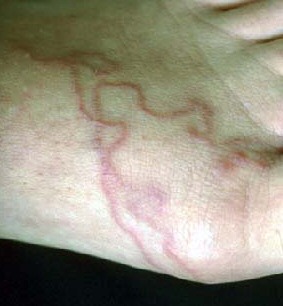Several roundworm parasites of domestic animals can
infect humans. It is usually the larval stages of these parasites that are
found in human tissues and provoke the clinical condition referred to as
larva migrans. Toxocara species, the ascarid of dogs and cats, most
commonly is associated with larva migrans. Classic visceral larva migrans (VLM)
typically occurs in preschool children with a history of eating dirt.
Children can present with severe infection and suffer from seizures,
myocarditis, and encephalitis. Death also has been reported in some cases.
Children contract Toxocara infections by
ingesting embryonated eggs. The larvae hatch in the small intestine, invade
the mucosa, and enter the portal system. The liver traps some larvae, but
other larvae proceed to the lungs and the circulatory system where they can
disseminate to virtually every organ. The parasite, however, cannot complete
its life cycle in humans. Larvae persist in tissues, provoking a
granulomatous reaction and eventually dying. Clinical manifestations depend
upon the tissue damage caused by the invading larvae and the associated
immune-mediated inflammatory response.
Frequency In
the US: The seroprevalence of Toxocara infection in
children varies from 2-10%.
Mortality/Morbidity: Death is rare. Long-term morbidity
is present with ocular larva migrans (ie, loss of vision in the affected
eye) but not usually with VLM.
Infection
primarily affects children aged 1-4 years, but it can occur at any age.
Children with VLM may complain of loss of appetite, fever, cough, wheezing,
or abdominal pain. Children may have marked hepatomegaly and splenomegaly,
wheezing, and rales. Children also may have a pruritic rash or urticaria.
Periorbital edema and strabismus also have been seen in some children with
VLM.
Causes are Toxocara canis is the most common
cause of VLM. Mature T canis worms live in the small intestine of
the dog, their natural host. Heavily infected dogs can pass millions of eggs
each day in their feces. Toxocara cati also causes VLM.
CBC often reveals
leukocytosis and eosinophilia, but eosinophilia may not always be present.
Children may be anemic. Obtain stool cultures to rule out other parasitic
infections. Elevated titers of isohemagglutinins to the A and B blood group
antigens support the diagnosis of VLM.
Enzyme-linked
immunosorbent assay (ELISA) is the most commonly used serologic test
physicians use to diagnose VLM, with a reported sensitivity of 78.3% and
specificity of 92.3%. Hypergammaglobulinemia may be present.
Imaging Studies Children with VLM may exhibit an
abnormal liver parenchymal pattern on both abdominal ultrasound and computed
tomography. Magnetic resonance imaging may reveal multiple cerebral lesions
in patients with central nervous system VLM. In unusual circumstances,
liver biopsy may aid in diagnosing VLM; however, microscopic identification
of larvae from biopsies occurs infrequently. A negative liver biopsy does
not exclude VLM.
Histologic findings show
multiple eosinophilic
abscesses and allergic-type granulomas in affected tissues.
Medical Care: Therapy is aimed at relieving symptoms
and is intended to diminish the host inflammatory response to the parasite.
Corticosteroids and antihistamines often are used for this purpose. Patients
with myocarditis or central nervous system disease should always be treated
with corticosteroids. Antiparasite agents, such as mebendazole, may help
reduce symptoms; however, systemic treatment with antihelminthics can result
in hypersensitivity reactions. Clinical trials have raised questions about
their efficacy. Attempt to identify the source of infection. Treat infected
puppies and kittens with appropriate anthelminthic agents.
Cutaneous Larva
Migrans is less severe. This is caused by hookworm larvae from the feces of
dogs and cats that is deposited on sand or sandy soil. Children or adults
who walk barefooted on the sand can have the larvae borrow into the skin and
travel around the area underneath it leaving a red trail as seen in the
picture. They travel 1-2 cm a day and can do so for months until they die.
The lesions are very itchy. So wear shoes and sit on blankets at the
beach. They are not found in the tide area so you are safe on the beach
close to the water.
